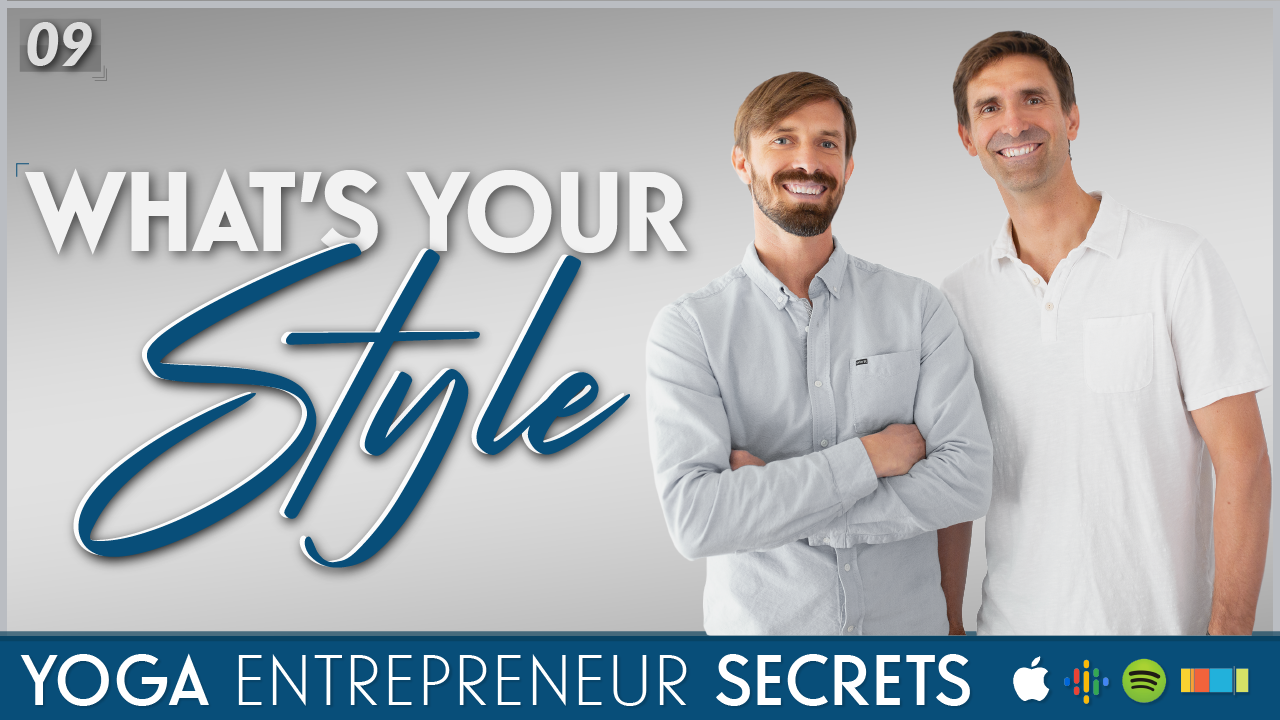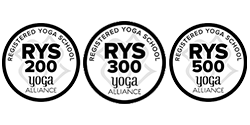09: What’s Your Style?

What Is This Episode About…
In this episode, we are going to talk about what Bruce Lee and yoga have in common. We will share the story of how we got into Jeet Kune Do and how it led us down the path that got us into yoga.
In yoga, everyone gets stuck on poses and what style is better than the other. In martial arts, we learned from Bruce Lee that “ranges” of fighting matter more than styles. The equivalent of “ranges” in the yoga world is the body, specifically the Myofascial Lines of the body. This should always trump a specific yoga style.
The minute we realized that we didn’t need to identify with a certain style of yoga and we were free to include the best movements in our sequences, it forever changed how we structured our classes.
Gone were the days of making changes just for the sake of making changes.
If we were making a change to our sequence, it was because there was a specific reason – not just because we got bored with it.
Key Points Discussed:
- Getting into martial arts and (00:37)
- The styles are only relevant to the range (03:16)
- Ego is everywhere even in yoga (05:28)
- Giving students the absolute best results (09:57)
- Teachers getting stuck in the idea of the style (12:14)
- Consistency in the methodology (14:17)
Learn More About The Content Discussed…
Join The Facebook Group –> http://bit.ly/yogaentrepreneur
When Was It Released…
This episode was released August 21, 2019
Episode Transcript…
00:00 What’s your style? Today we’re going to talk about what Bruce Lee, and yoga have in common.
00:07 What’s up everyone? You are listening to Yoga Entrepreneur Secrets. I am Chris Yax, and I’m John Yax. We are part of a small group of yoga entrepreneurs who are committed to making a living, doing what we love, without feeling guilty about making money, or ashamed of being successful, because we know the real value of yoga and how the world needs it now more than ever. This podcast is here to teach the strategies and tactics so we can thrive financially as yoga entrepreneurs. We are the Yax brothers and welcome to Yoga Entrepreneur Secrets.
00:37 Alright. I’m excited for this one. I am so excited for this one. Why John? Why are you so glad? Well, we got into martial arts way, way back in the day. It’s been 23 years, 20… it’s been…. about 20, almost 24 years I think. So… time doesn’t exist, John. I have no idea. It doesn’t exist, Chris. It exists for me. We got into martial arts when we were in our early twenties, late teens actually. Yeah, late teens. And, we practiced for a little while and eventually got into style…met a gentleman, John Davis, who’s rocking in Jeet Kune Do concepts. He introduced us to Jeet Kune Do concepts, and… what is Jeet Kune Do concepts, John? I know, I know, I know. I’m getting to that. And, it just blew our minds. We were like, “Whoa!” Well, Jeet Kune Do concepts was a philosophy of martial arts that Bruce Lee developed. He developed this way back in the day, and his whole philosophy… so I’m not going to get too big into the martial arts world with you guys, but his whole idea was looking at martial arts in a specific way and what everybody at the time was doing within the martial arts world was studying one style, and everyone’s idea was this style is the best style.
01:51 It’ll beat all other styles. “Oh, I do a kicking art.” That’s good. That’s the best style because I can keep you at a distance and then just kick you, because the legs are stronger than the arms. So, when I do a wrestling style, I’ll shoot it on you, take it down, and then I’ll dominate you. Well, you gotta be able to take me down first, and if I understand how to do takedown defense, then you’ll never take me down and I’ll win. Well, I do a knife-throwing style, you better run your butt off. Well, I sneak into people’s houses for a living. So, on the night before the fight, I’m going to kill you. So, it was… so what Bruce Lee realized is, everyone had it wrong. He said… he was like, “It’s not about styles. All styles are good if they can maintain the range.”
02:32 What he said is, “You have to look at the art of fighting from a different perspective.” And it’s not style based because that’s… you just can’t win that, meaning like, it’s range based. Range; what we’re talking about, and I know you’re like, “Wait, this is a yoga podcast. Why are we talking about martial arts?” I’m I on the right podcast? Yes you are. Just give us a second. So, ranges of fighting are the distance that you are between your opponent. Right? So if you’re way far away, you can throw stuff, or you have sticks like weapons and stuff like that. Right? You get closer and you have like a kicking range, where your legs are longer than your arms, so you should be able to kick. And, if you get even closer than that, you have punches, or you can like, throw punches, and you can probably knee and elbow at the same time.
03:16 You get a little closer than that, and then all of a sudden you can now grapple standing grappling where you catch the neck and catch the arm and like headless knees, elbows, knees and elbows and throws. And then guess what? You get thrown or you go to the ground because you don’t know how to fight. Then you’re on the ground and you gotta learn ground fighting. So what Bruce Lee said was, oh, forget all the styles. The styles are only relevant to the range and if you get stuck in one style, then you’re missing all these other ranges that you’re going to need to know. Because of how a fight is so dynamic, it’s going to go from kicking the punching back to kicking to grappling, to standing, grappling to the ground and back up again. And you got to understand at least have some proficiency in all of the ranges to be effective as a fighter.
03:59 So what Chris and I did is we studied all these ranges. We met amazing teachers and eventually through press training so hard, we got into yoga and when we got into Yoga, let me say this for a second, let me back up. So, but even this was Bruce Lee’s philosophy that he developed back in like the late fifties early sixties when he like unleashed it. Obviously, it was probably brewing in his mind and in his training methods way before that. But then there was evolution and he was working on it constantly until his death. But yes, but so there are even like all the way up until the ultimate fighting championship, I think it was like 93 when that came out, there was still that idea of my styles better than your style. This is how far ahead he was. And before his time is that even when we were in it, there was still this idea that one style is better than the other.
04:44 Oh Western boxing is the best or this style is the best. And we were like, we got, fortunately we are in g condo concepts, which is what the philosophy was based on. So we understood the rangers, we understood the common thread and that’s what we are practicing. But where John going is all the sudden we were beaten up and broken and we fell in love with yoga. We got into yoga to try to heal us. So that specifically our idea was if we can heal, we can get to training faster, get back to training faster. Well we started practicing yoga. We were like, Whoa, this stuff is magical. It’s so magical. It’s so amazing. So we were like, we’re going to go to training, we’re going to like get involved in it. Like go do this thing. And so we started practicing and the heated style and we went and got certified to teach in that heated style.
05:28 And we got into it. We thought, well this is yoga. So everyone’s going to be like combine. Ah Oh peace, love, happiness. All styles are good man. Harmon style, that style you just do. We’re all one. It’s all good. And guess what? The craziness is everywhere guys, because we bring our crazy everywhere. Ego is everywhere. And in Yoga, even in Yoga, even in Yoga, the crazies there, what we realize when we came back from training, we started teaching. All of a sudden we had people in the that were like, I’m an Ashtanga [inaudible] and a hot yoga is not even really even to yoga. I do a Yang Gar and hot yoga is not even really yoga. It’s just fake. We got the same stuff. It was the same thing we were experiencing and martial arts where my style is better than your style, your style. Well I don’t have a style.
06:20 And so what we were searching for, and this is what we had an awesome first teacher training and but what we didn’t get in it was the bigger why, like why do we do what we do? Like what? Cause, and we knew that there was something out there like that because that’s what we came from in the martial arts world. It was like, man, we know that there’s gotta be some equivalent to ranges in yoga. And so we went on the search and we started with people and we eventually found it right? We started with Ralf gaze, we started Johnny Gillespie and we, and what where they let us was to Thomas Myers, which interestingly enough, and this is the value of like not getting stuck and looking in the yoga world for answers, but also looking at other modalities. And there’s been studies that shown like when you’re able to blend and look at other industries and other modalities and to see what they’re doing, creativity expands.
07:13 And so Thomas Myers is a body worker, he’s a golfer. So where Chris is going with this is what is the equivalent in yoga to the ranges in martial arts? And it’ll be real specific. Like the way Bruce Lee looked at martial arts and said, no, no, no, no, no guys, you guys, everyone has it wrong. They’re not looking at it from that thousand feet up. They’re not looking at it from that higher perspective. Because of our background, because of we trained in [inaudible] concepts. When we got into yoga, we eventually decided we’re searching the same thing. We’re like, what is the equivalent? What’s the, if we take y’all to look at a thousand feet out, what is the equivalent and what the equivalent is? Are My fashion lines the body? It’s the body. Everybody has specific parts of their body that are the same. Regardless of your age, regardless of who you are, where you were born, you have the same thing.
08:01 It is the equivalent to range as in fighting these lines of connected tissue in the body. It is the body itself. And so if we can look at our classes and develop our classes around this, all of a sudden styles become irrelevant. Yeah. Poses honestly become irrelevant in the way that most people think about it. It’s very like yoga is very posed centric. Right? And if someone thinks about yoga and you ask them on the street, Hey, what’s yoga? They’re gonna like throw out an up dog or a down dog and like that’s just the prevailing understanding of like what yoga is. It’s way more than that but this episode, let’s just leave it there and say it is about that and but it isn’t at the same time because when I look at a down dog, if it’s just the pose, then I don’t know why I would put that pose where it is.
08:44 But if I understand what it’s doing for the body, going back to, oh, what all poses do is something very specific for the body and not just the body in general but very specific part of the body that we break down into what’s called myofascial lines, which is just like connective tissue and these lines that connect to each other and we’re not going to go too deep into it, but like literally blew our minds up with this was that, oh now I am so wide open as to I don’t need to become like an Ashtangi or Ion Gari or like whatever other styles there is and be bound to that and not understand why. Because of why. I would make a change if I ever needed to make a change because I’m now, I’ve like broken myself out of the understanding of, Oh, this is just a sequence that I have to teach a sequence and now I’m going to get creative and I don’t know why I would change the sequence, but I’m gonna start changing the sequence in some way because I’m bored with my sequence now we can make like anatomical, like smart scientific decisions within our sequencing because we’re not looking at the poses in and of themselves, but we’re looking at the poses for what they do to the body.
09:57 It’s a systematic approach, a framework to be able to sequence your classes, to be able to sequence what you’re doing for your people, to give them the absolute best result. Because ultimately that’s what we want. We want the best result for our students. And what is that? Basing my teachings around a framework that works every single time, no matter whether you’re five years old, 95 years old, anywhere in between. I can look at a body and say, this, this, this, this. I can bring a group of people together in a class and know exactly what I’m going to do when I’m gonna do it because I understand this framework. That’s it. And so the challenge is when we get so locked into a style that we think, okay, I have to teach it exactly like this because this is what my teacher taught. And then you’re presented with an opportunity to teach at a retirement center, right?
10:51 What do you do? There are 75, 85, 95-year-old people in front of me. The cheddar, Ranga old man. Let’s do a jump back for the very first pose. And then when I said Chad Uranga, I know that there’s a crow in my sequence that my teacher taught. So we’re going to do a crow here. Come on guys, jump in, jump on your chairs, let’s do this. Or if you’re teaching to your child’s school and all of a sudden it’s a bunch of five-year-olds, six-year-olds, seven-year-olds, like what do you, I actually had that experience. I was teaching at a local place called my gym, which I think is more of a national chain. And I thought, cause I came like what I learned in teacher training was here is a sequence called the hot yoga sequence, right? And then it was very stationary and then I’m teaching three to five-year-olds, man, three to five.
11:36 I have three, I have a three and a five-year-old. I totally get it. I had no idea back then what a 3 or 5 year old level of energy and a level of focus and attention span was actually like they’re capable of. And so here I was like, okay, like reach the arms overhead and it relates to fingers release the index fingers and let’s move the body to the right. The hips gently to the left. And in a second the boys were making guns and shooting and the girls were like little candles floating in the wind. And like I lost all control, total control, control, meltdown. And I had to flip it quickly and say, oh no, no, no, no, this isn’t working for them. Let me do something that works for them and their attention span. So he in the moment had to shift it.
12:14 And this was prior to us understanding this framework? Yeah, yeah, totally. Prior to us, we’re still stuck, like most teachers are right now stuck in this idea of here’s the style that I learned in teacher training that my teacher taught me and then this is the style that I have to teach, or even worse. So no methodology just as here’s a style and no explanation of why to teach it. Or even worse, here’s a bunch of poses. I won’t tell you how they all go together. I’m just going to teach you a bunch of poses and you put them together, you figure out how you want to put them together, but not really based on launch. You’ll put them on cards and put it in a box and kind of throw it out on the floor and see what, how it lands and then that’ll be your sequence for today.
12:53 Yeah. And it’s not like for us, that’s just not acceptable because I want, if anyone comes out of a class of any teacher that we’ve ever taught or ourselves and they say, well, why did you do that pose at that position at that time? I want to have like a very specific answer for them that’s not based on, it just kind of goes well with the pose I did before and the one I did after it, but something more anatomical and scientific about actually what’s going on and why I would do that for your body and your wellbeing so that you get a result, meaning a feeling afterwards that’s consistent over time. And it was never okay for us to hear the answer, well that’s what my teacher taught me or that’s what my teacher told me to do because you’re just sloughing off the responsibility of not knowing why you’re doing what you’re doing on someone else.
13:40 And for us, like so one of the things we did was for the first two years we didn’t change the sequence. Why? Because we didn’t know why we changed a sequence that was during the search of like, why are we doing what we’re doing? It doesn’t make sense for us and I’m not going to go ahead and just change it just because I feel bored about it because I don’t want to compromise my students while wellbeing and do something that would potentially harm them. So this is the other value of it and so is when we have students who leave our teacher trainings, we don’t know where they’re going to end up. I don’t know what the student body that they’re going to be in front of looks like. I don’t know if it’s going to be elderly people. I don’t know if it’s going to be kids.
14:17 I don’t know if it’s going to be wounded warriors, but I know that if they understand the why, right, the bigger picture of why we’re doing what we’re doing, like on a more spiritual level even. But even keeping that off the off the table for right now and just say on a physical level, why do I sequence the way I sequence? Why is this pose here, in that pose there? Why do I wait to do this later before like and I don’t do that until these things are done. If they understand that, then I know when they get in front of the person to, I don’t know they’re going to be in front of, they will be able to teach to them because as teachers and as entrepreneurs, we need to start where our students are and to be able to meet them where they are is going to give them the ability to like really have this practice take hold of them, to give them the result that they’re looking for so that it can be a lifelong practice for them and that’s what it comes down to.
15:06 The last piece I’ll add to this is that when a student comes out of a class that’s taught with this specific framework and this methodology, they feel amazing every single time because we are addressing the most common misalignment disorder comes to mind, but that’s not quite that intense, but it’s misalignments. The most common patterns of the body had earns, right Ms patterning almost in the body that are present in people and you can sit down and people watch for a moment, you’ll see it, you’ll see a deep swayback, a lordotic curve, the see a hunchback people head, forward head tilts. You’ll see that in people. And when you approach the practice in a specific framework, they come out feeling amazing because they are retraining those misalignments in their body that those patterns. So, so that’s the other beauty of it is that if you approach it every single class you do the work, do the work, do the work, or they do the work, they come in consistently, they’re going to get the results.
16:03 And when people feel the results, they keep coming back. So yeah, it’s the secret to success, not consistency and the methodology and getting people to break free from the patterns that they have in their bodies and their minds. And the way to do that is through consistent experience, a consistent methodology. And one that’s not student-focused, not teacher-focused based on my own creativity and me getting bored about what I’m doing next to him. The next day, Yoga One oh one y’all break the patterns in the body, break the patterns of the mind, break the patterns of the heart, and you’ll liberate yourself. You’ll be free. Yeah, we appreciate it.
16:38 You’re uh, taking the time to listen and definitely join us on the next episode. I’ll see you then. Thanks. Yes, thanks so much for listening to Yoga Entrepreneur Secrets. Do you have a question that you’d like us to answer raw and uncut on the podcast? If you want your questions answered, all you need to do is head over to Apple Podcasts, and do three simple things. One; rate and review telling us what you think of the podcast. Two; in that review, ask anything you want related to yoga, and three; if you want to shout out, leave your Instagram handle or name and that’s it. Then listen in to hear your question answered Live, raw and uncut. Join us next time on Yoga Entrepreneur Secrets Podcast. Thanks.
Comments are closed.


